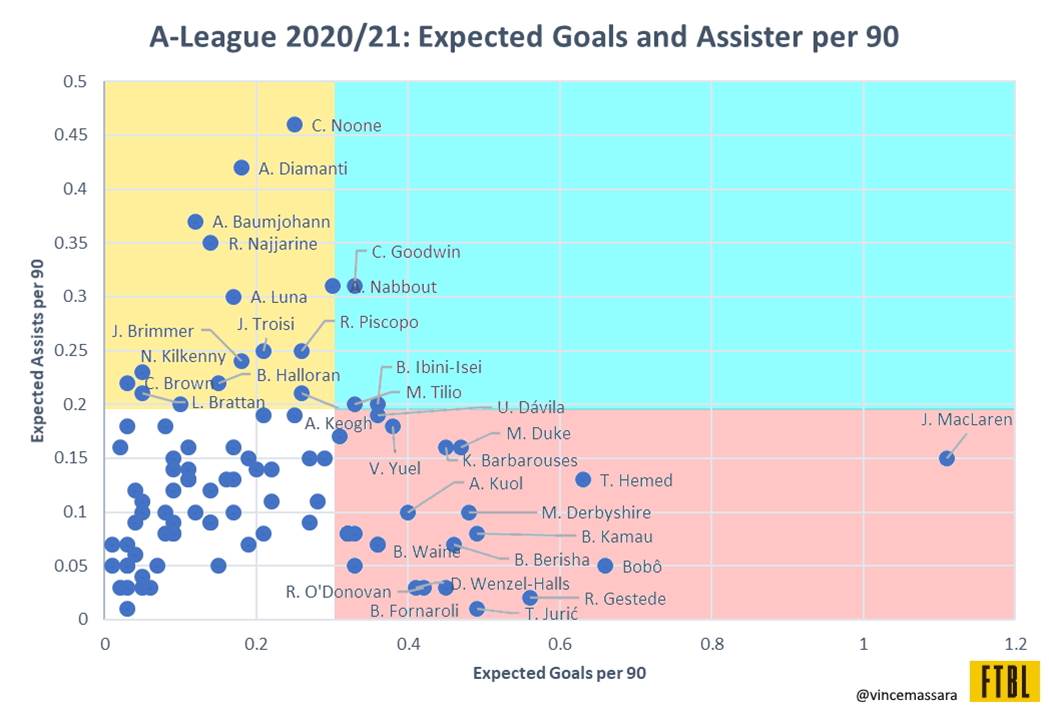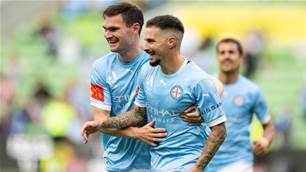When you're looking at ways to assess attacking players, there are plenty of ways to go about it - and in all honestly, there's no 'one true way' to get a definitive correct answer.
Well, besides Jamie Maclaren being an absolute goal-scoring machine; that's definitive.
But besides that, there are a few ways you can assess attacking threats. In this article, we'll look at the expected goals and assist totals for attacking players last season, and talk more about a few key players.
What are A-League expected goals, and expected assists?
Expected goals (xG) and expected assists (xA) are becoming more and more a part of general soccer conversation these days, however, they're not exactly terms known by every fan - so here's a quick rundown.
Expected goals (xG) look at where a player shoots from and give that position on the field a value from 0.00 to 0.99, with the higher number, the better. So, for example, a shot from outside the 18-yard box is going to have a much lower number, or xG, than a tap in on the goal line. The angle of the shot is also considered, with a shot directly in front being more likely to score than one on a tight angle.
An expected assist (xA) is just the pass that leads to a shot. So if a player passes to someone that shoots from a spot with an xG of 0.12, that player that passed to them will get an xA of 0.12.
Using expected goals and assists combats players that might have been lucky or unlucky with their shooting - with that, they're more predictive of future performance.
Looking at the 2020/21 A-League Numbers
Here is a graph showing the leaders in expected goals and expected assists last season in the A-League on a per ninety-minute basis according to Wyscout.
I’ve averaged everything out to a per 90-minute basis to try and accommodate for players that missed a few games. I’ve also only included players that played over 900 minutes in attacking positions to eliminate a substitute who may have come on for ten minutes here and there, getting a few good shots and skewing their numbers.
Players listed in the yellow square had high expected assists and low expected goals, the players in red had high expected goals and low expected assists, and those in the blue square were high in both expected goals and expected assists last season.

I've included a few of the players' names here so you can explore the results yourself. However, here are a few of the players in that graph that stand out to me.
The first name that jumps out to me is Jamie Maclaren, all by himself over there on the right of the graph. Jamie Maclaren's numbers last season were outrageous, but that's not news to anyone. To score 25 goals in 24 games is some video game level production. His expected goals back that up too, with over one expected goal every game - Maclaren isn't inflating his numbers with a lucky shooting streak.
He's still only 28 years old too, so if he stays in the A-League, you'd expect him to get the 38 goals needed to catch Besart Berisha's record of 142. Hell, the rate he's going at, he'll have it done within a couple of seasons.
Alongside Maclaren, there's a cluster of strikers that we'd expect to see on a graph like this: Bobô, Tomer Hemed, Matt Derbyshire, Bruno Fornaroli, Mitchell Duke, and Tomi Juric all expected to score around a goal every two games. There are also a few lower on the scoring list like Dylan Wenzel-Halls which may surprise a few.
After checking out the players at the top of the xG standings, the two assist kings from last season are interesting cases too. Craig Noone was racking 0.46 xA per 90 last season. To average, nearly half an expected assist a game is crazy - granted when you've got a striker like Maclaren, and the general attacking unit that Melbourne City had - that gets boosted a little. Regardless, Macarthur FC will hope that Noone can recreate that magic with fellow new signing, Tomi Juric.
Alongside Noone is the Italian ace, Alessandro Diamanti. The midfielder is the straw that stirs the drink at Western United, and his 0.42 expected assists a game is proof of that. Diamanti's numbers are even more impressive when you consider that Western United only scored around half the goals that Melbourne City did last season.
As you can see by their position on the graph - neither Noone nor Diamanti troubled the scorers too much. Noone's 0.25xG per 90, and Diamanti's 0.18xG per 90 meant they weren't getting many quality chances.
Along with the two xA leaders, Alexander Baumjohann and Ramy Najjarine had great numbers, hovering around the 0.35 xG per 90. Again, neither Baumjohann nor Najjarine added too many great chances and are on the lower side of the expected goal chart.
Now, I want to discuss the players that are the most well-rounded in the league - those in the blue box that had high xG and xA per 90 numbers last season. Andrew Nabbout and Craig Goodwin were both impressive attacking threats. Nabbout formed an incredible attacking trio with the previously mentioned Maclaren and Noone, if you combine Nabbout's expected goals and assist numbers, he averaged 0.6 xGA (expected goals plus expected assists) per 90 minutes - that's a very productive forward.
However, as has been said a few times, Melbourne City's attack was absolutely off the charts last year, so their attacking players would obviously have good numbers.
Craig Goodwin has looked awesome since coming back to Adelaide, so his numbers last season won't be too surprising - but he's a player that probably doesn’t get as much love as he deserves. To average 0.64xGA per 90 minutes is insanely productive - while he scored a bit above his expected goal total, the chances he created weren't often put away so it kind of evens out.
Along with Goodwin and Nabbout, there were some other players thereabouts too - Bernie Ibini-Isei was productive at Western Sydney, and youngster Marco Tilio's numbers show the Melbourne City man's performances were well worth the hype and Olyroo call-up. Ulises Dávila is another with impressive numbers, with the reigning Johnny Warren Medalist averaging a combined 0.55 xGA per 90 minutes. However, it's interesting to know that Dávila's assist numbers were a bit inflated, with his 0.19 expected assists per 90 converted at the rate of 0.33 assists per 90. That may not sound like a lot, but over a whole season, that gives Dávila seven assists from just over four expected assists - for context, that would move him from equal third in the assist table to outside of the top ten.
While Dávila's assist rate was inflated last season - he's still an incredible player as his xG and xA numbers show. If all goes according to plan, Macarthur FC will have a lot of great attacking options next season and could challenge Melbourne City as the best-attacking team in the league if their new players gel quickly.
Related Articles
.jpeg&h=172&w=306&c=1&s=1)
Melbourne's Maclaren off to India, Yazbek US bound

City's Socceroos striker not in ALM All Stars squad













